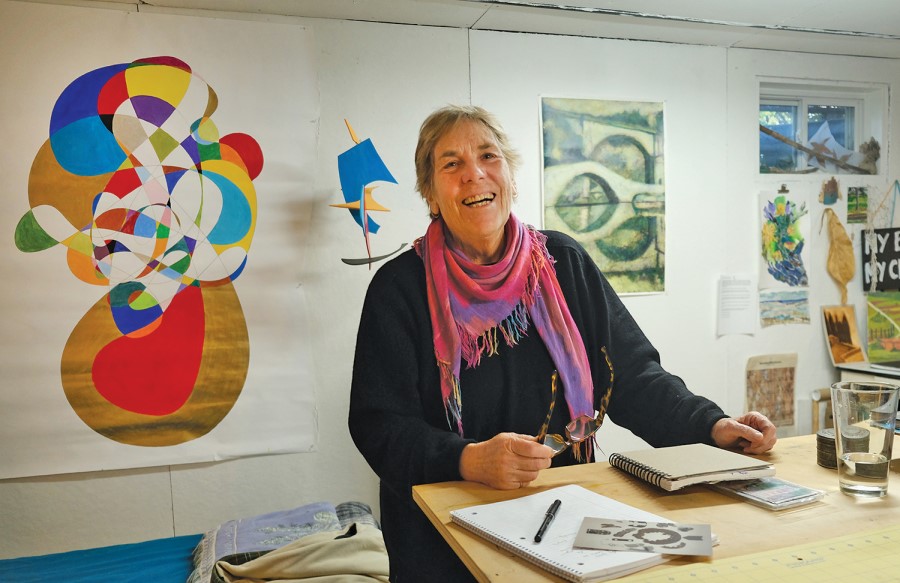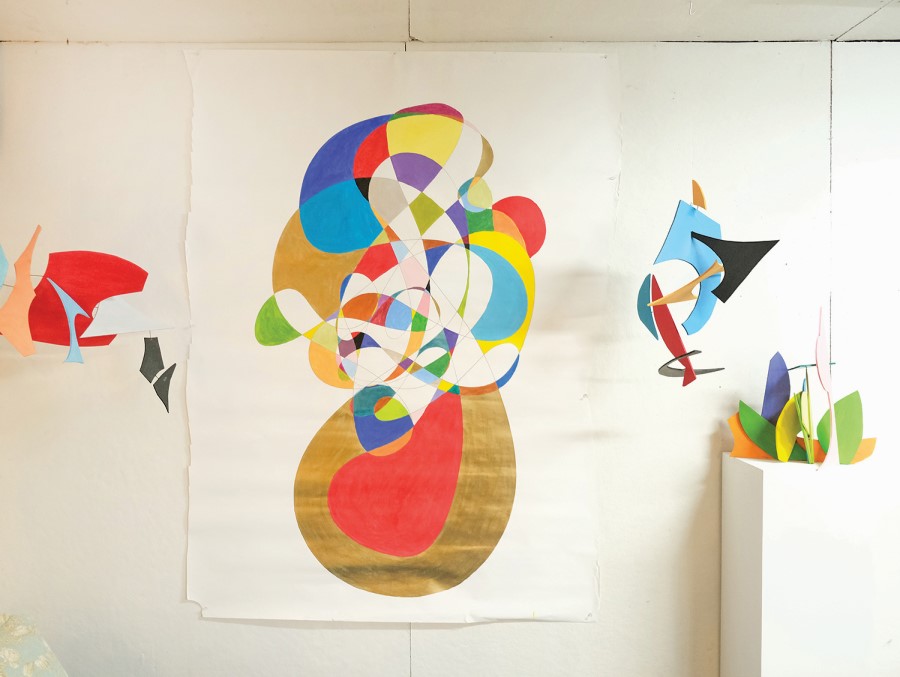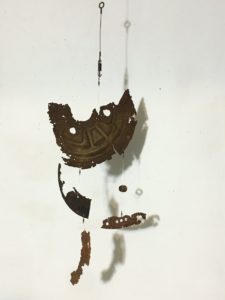EASTHAM — Margot Stage had a career in public radio as a producer for WGBH in Boston where she worked primarily with words and sounds, creating stories by combining interview clips, ambient noise, narration, and music. She’s still creating but with an expanded lexicon of materials including fabric, rusted car parts, neckties, piano keys, chocolate wrappers, and anything else that captures her attention.

“Putting together a radio show is not unlike producing a fabric art piece or a sculpture,” says Stage. “It’s telling a story by putting pieces together.”
She points to Vernal, a small sculpture in her Eastham studio made of intersecting geometric shapes painted in bright colors. “It’s about spring, new growth, and uplift,” she says. Nearby is the sculpture’s two-dimensional counterpart: a large swirling drawing from her “Crazy 8s” series, which she worked on during a residency at Mass MOCA. Stage says it connects to a childhood memory of “lying on the floor making shapes, and coloring them in.”

The impetus for her artwork often comes from encountering a particular material. Even the large drawing began from a discard: a huge roll of paper that a printing company was giving away. Usually, her materials are less traditional.
In her “Metal Mania” series, which was exhibited this summer at the Greenwald Gallery in Lowell, Stage began by collecting pieces of discarded metal — typically car parts, often rusted beyond recognition. “For about 20 years I would spot pieces of metal on the road and sidewalks,” she says. “They just spoke to me. I couldn’t resist them.” When she and her husband, David Crane (who is also an artist), moved to Eastham from Westford in 2017 she brought “this pile of metal” with her. “It’s only been growing,” says Stage. Eventually she began composing the pieces into sculptural forms.

“I attach the pieces with wire, pop rivets, gravity, and glue,” says Stage. “I don’t alter the pieces, and there’s no welding.” The playful compositions reveal a delicacy that contradicts the industrial grit of the material. In Grin and Bear It, crescent-shaped shards of metal, rusted into lacy textures, hang from dainty wires in a precarious gesture of balance and circular movement.
The allusion to lace in some of these metal pieces recalls Stage’s work with fabric, which was instrumental to her development as an art maker. (That’s the term she prefers to describe herself, which she says came to her in a dream and felt right: “I’ve called myself a sculptor, a fabric artist, and an installation artist — but none of them told the whole story.”)
While working on a bookmaking project in 2001, Stage found herself captivated by visual art. Fiber artist Maxine Farkas became a mentor. “She opened up her studio, and it was like being in a candy shop,” says Stage. She began creating images — often landscapes — by “putting together layers of fabric and stitching them,” she says. “It’s like painting without paint.”

By 2008, she had retired from radio to pursue art full time. “I never went to art school,” she says. “I’ve been self-taught and learned by the seat of my pants. Sometimes I wish I’d embraced making art full time when I was younger. But I’m doing it now and having a lot of fun.”
Stage’s sense of fun is on full display in her basement studio. She lives in a condominium development with manicured lawns. The expansive basement, which she shares with her husband for studio space, was the main selling point of her home. While its exterior is unassuming, the basement is like a cabinet of curiosities, filled with collections stored in bags and bins neatly stuffed under tables.
“Found materials thread their way through my work,” says Stage. “A lot of it is about memory or legacy.” Many of the objects in her studio have found new life in Stage’s hands. Others remain bagged and boxed, waiting to be shaped into a story. “It’s stewing,” she says of her creative process. “It’s simmering.”
Under a sewing machine in one corner, plastic bags bulge with Dove chocolate wrappers. In another, Stage stores crates of bobbin spools and coat hangers and a box of 35mm film that belonged to her late father, a photojournalist. “I have an obsession with the inside of envelopes,” she says, pulling out a flat file drawer stuffed with envelopes that have been flattened to reveal a variety of interior patterns.
“I don’t know what I’ll do with these,” she says, laughing. But she’ll come up with something.



